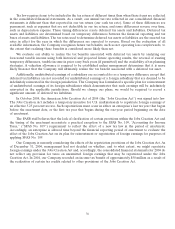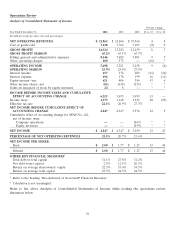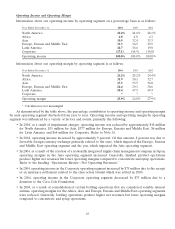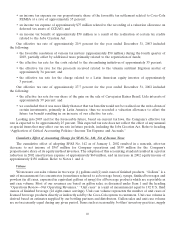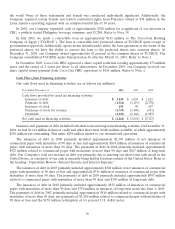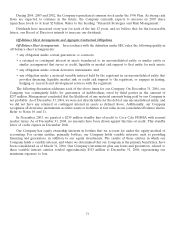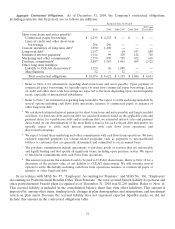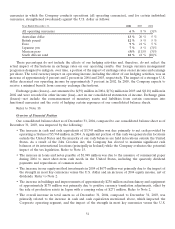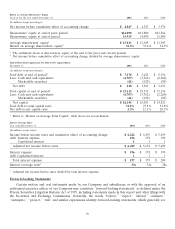Coca Cola 2004 Annual Report Download - page 48
Download and view the complete annual report
Please find page 48 of the 2004 Coca Cola annual report below. You can navigate through the pages in the report by either clicking on the pages listed below, or by using the keyword search tool below to find specific information within the annual report.
• an income tax expense on our proportionate share of the favorable tax settlement related to Coca-Cola
FEMSA at a rate of approximately 35 percent;
• an income tax expense of approximately $75 million related to the recording of a valuation allowance on
deferred tax assets of CCEAG; and
• an income tax benefit of approximately $50 million as a result of the realization of certain tax credits
related to the Jobs Creation Act.
Our effective tax rate of approximately 20.9 percent for the year ended December 31, 2003 included
the following:
• the favorable resolution of various tax matters (approximately $50 million) during the fourth quarter of
2003, partially offset by additional taxes primarily related to the repatriation of funds;
• the effective tax rate for the costs related to the streamlining initiatives of approximately 33 percent;
• the effective tax rate for the proceeds received related to the vitamin antitrust litigation matter of
approximately 34 percent; and
• the effective tax rate for the charge related to a Latin American equity investee of approximately
3 percent.
Our effective tax rate of approximately 27.7 percent for the year ended December 31, 2002 included
the following:
• the effective tax rate for our share of the gain on the sale of Cervejarias Kaiser Brazil, Ltda interests of
approximately 39 percent; and
• we concluded that it was more likely than not that tax benefits would not be realized on the write-down of
certain investments, primarily in Latin America; thus we recorded a valuation allowance to offset the
future tax benefit resulting in an increase of our effective tax rate.
Looking into 2005 and for the foreseeable future, based on current tax laws, the Company’s effective tax
rate is expected to be approximately 25 percent. This expected tax rate does not reflect the effect of any unusual
or special items that may affect our tax rate in future periods, including the Jobs Creation Act. Refer to heading
‘‘Application of Critical Accounting Policies—Income Tax Expense and Accruals.’’
Cumulative Effect of Accounting Change for SFAS No. 142, Net of Income Taxes
The cumulative effect of adopting SFAS No. 142 as of January 1, 2002 resulted in a noncash, after-tax
decrease to net income of $367 million for Company operations and $559 million for the Company’s
proportionate share of its equity method investees. The adoption of this accounting standard resulted in a pretax
reduction in 2002 amortization expense of approximately $60 million, and an increase in 2002 equity income of
approximately $150 million. Refer to Notes 1 and 4.
Volume
We measure our sales volume in two ways: (1) gallons and (2) unit cases of finished products. ‘‘Gallons’’ is a
unit of measurement for concentrates (sometimes referred to as beverage bases), syrups, finished beverages and
powders (in all cases, expressed in equivalent gallons of syrup) for all beverage products which are reportable as
unit case volume. Most of our revenues are based on gallon sales, as discussed under Item 1 and the heading
‘‘Operations Review—Net Operating Revenues.’’ ‘‘Unit cases’’ is a unit of measurement equal to 192 U.S. fluid
ounces of finished beverage (24 eight-ounce servings). Unit case volume represents the number of unit cases of
licensed beverage products directly or indirectly sold by the Coca-Cola system to customers. Unit case volume is
derived based on estimates supplied by our bottling partners and distributors. Gallon sales and unit case volume
are not necessarily equal during any given period. Items such as seasonality, bottlers’ inventory practices, supply
46


